MLS Power Rankings Week 1: Piatti, Magee thrive on opening day

The first stages of Major League Soccer seasons normally look sloppy, and many of Sunday’s opening-day matches fit that bill. Defenses are far from familiar in Week 1 despite going through preseason together, and attackers can usually take advantage to the tune of multiple goals per game.
Certainly, neither the New England Revolution nor the Houston Dynamo defended well in their first match of the season. It finished 3-3, with 27 shots between the two teams flying toward goal in a game with multiple errors on the back end.
Indeed, only four teams failed to score on Sunday, and just two of 10 games finished with a solitary goal. New York City FC turned in a crazy 4-3 win over the Chicago Fire, in which NYCFC was the only team to lead in the match to give Patrick Vieira a victory in his MLS coaching debut.
Sebastian Giovinco, the reigning league MVP, kick-started his season by orchestrating a 2-0 win for Toronto FC over the Supporters’ Shield-holding New York Red Bulls. In keeping with the theme, he also pantomimed kick-starting a motorcycle in his goalscoring celebration after he put away the 82nd-minute penalty that would prove to be the winner.
Toronto's was as close to a statement of intent that you can get on opening day in MLS, one coming from a team that has made a lot of noise without really winning anything in its history. However, its Canadian neighbor Montreal Impact made a statement of their own in a 3-2 win over the Vancouver Whitecaps, with Ignacio Piatti stepping up big in Didier Drogba’s turf-induced absence.
In another wild, multi-goal game, Orlando City SC scored in the 94th and 95th minutes after going down 2-0 to Real Salt Lake to earn a point. It was a rough game, with both teams going down to 10 men before halftime.
The 2016 MLS Ambition Rankings
The best teams from the Western Conference in 2015 continued their winning ways, with FC Dallas taking probably the most comfortable victory of the week in a 2-0 match against the Philadelphia Union. The Portland Timbers, meanwhile, won their MLS Cup rematch against the Columbus Crew, 2-1, despite Federico Higuaín’s acrobatic overhead kick that equalized the match for 11 minutes in the second half.
The San Jose Earthquakes and Sporting Kansas City turned in the only 1-0 results of the week, defeating the Colorado Rapids and Seattle Sounders, respectively. Finally, to cap a long day of MLS play, the LA Galaxy came from behind to defeat D.C. United, 4-1, despite losing new starting goalkeeper Dan Kennedy to a first-half injury. Mike Magee thrived in his return to the Galaxy, coming off the bench at halftime and contributing two goals and an assist in addition to drawing a penalty.
Here are some highlights from the kickoff to MLS’s third decade of play:
Coach’s Corner: Breaching Seattle’s three-headed monster
The Sounders’ new 4-3-3 look has been built up all offseason, created in an effort to get all of their attacking pieces on the field at the same time. Even with the loss of Obafemi Martins to China, coach Sigi Schmid stuck with the system against Kansas City.
It featured three narrow forwards in the attack, as the trio of Clint Dempsey, Nelson Valdez and Jordan Morris doesn’t contain a true winger. That put a lot more pressure on the fullbacks, Joevin Jones and Oniel Fisher on Sunday, to provide width moving forward.
In turn, that created tricky situations in transition moments, particularly when Seattle lost the ball in the initial phases of build-up. In the 21st minute, Dom Dwyer picked off a ball in the top half and had a huge gap to slip the ball to Connor Hallisey, but goalkeeper Stefan Frei came up with the save.
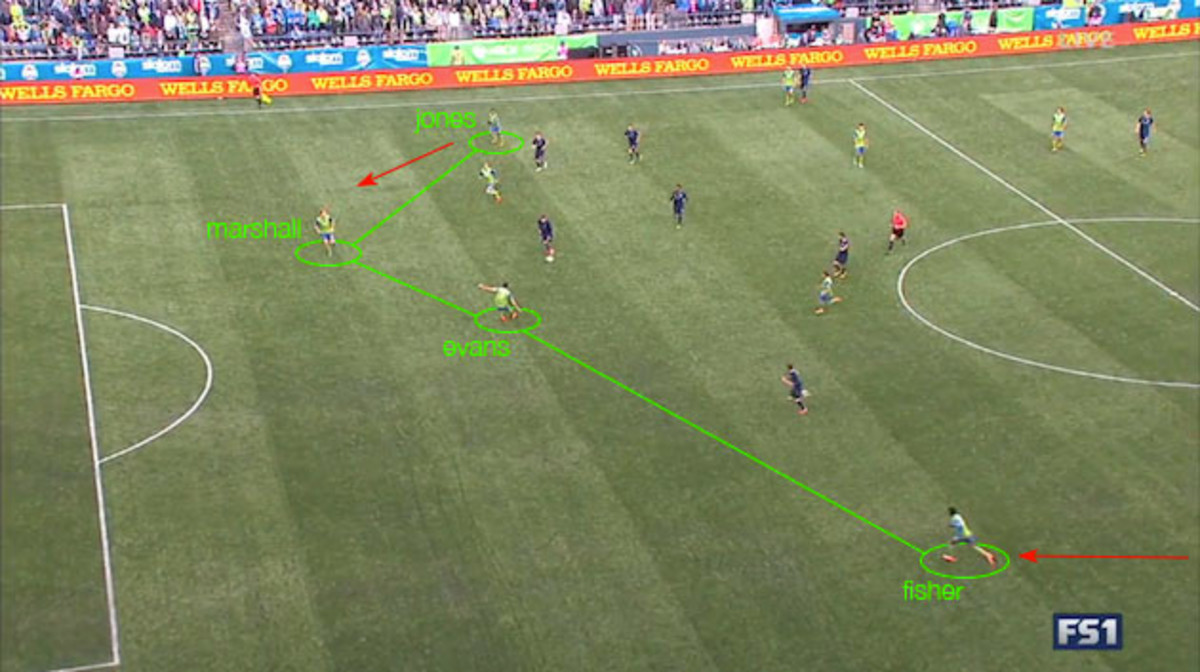
A moment like this is also what led to Fisher’s sending off just before halftime, as he scrambled back into a reckless tackle in transition, completely changing the complexion of the game. Fisher’s speed makes him a flashy player, but much like DeAndreYedlin in the same position before him, he’ll need to balance that better with his defensive responsibilities.
Relying on recovery speed could leave his team in trouble in those moments all season, as opponents could target that space the fullbacks leave behind when they move forward. Kansas City, whether consciously or not, sent many of their outlet passes in the back and middle thirds into those wider areas.
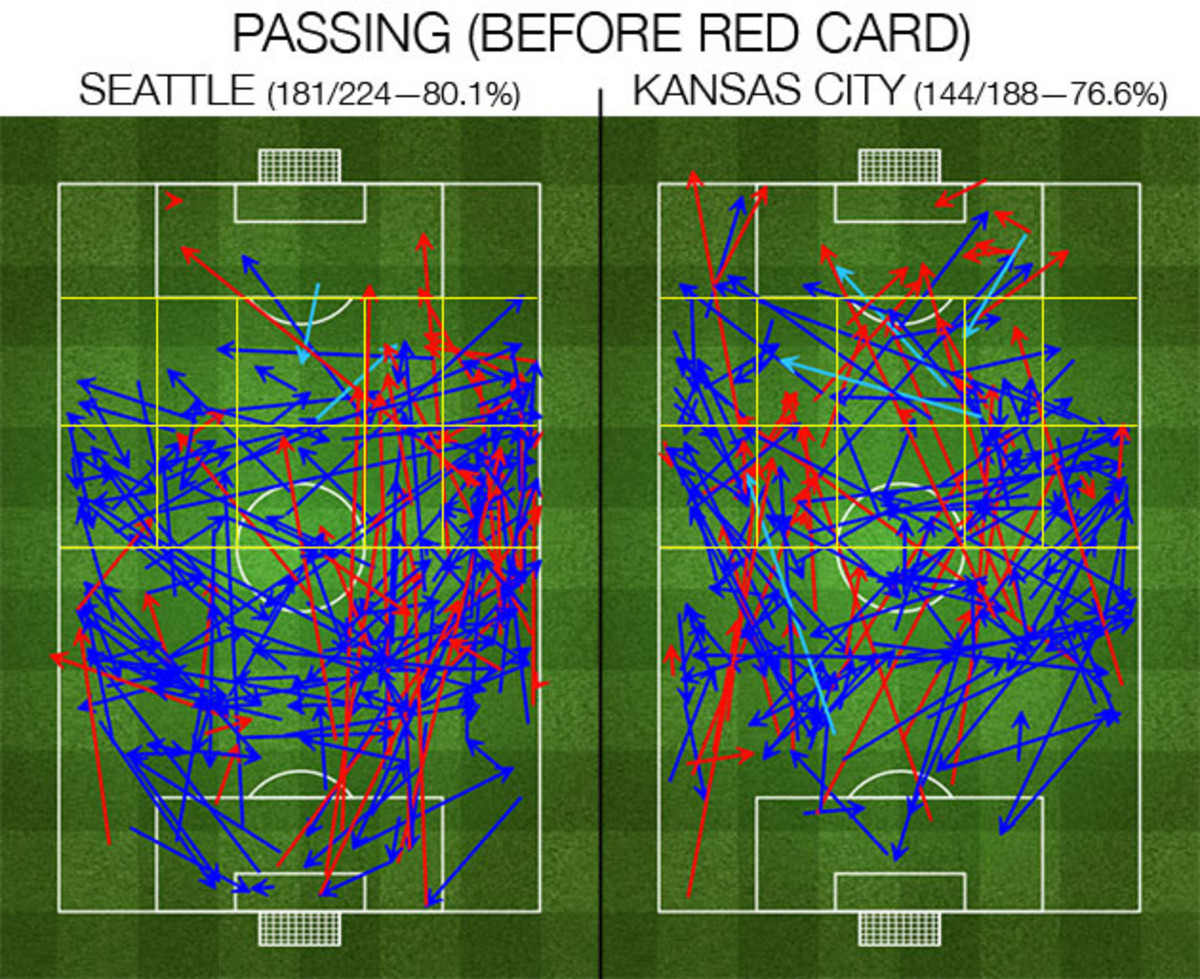
With the important role he played defensively as usual, it’s hard to believe Osvaldo Alonso looked like he was on his way out of the Emerald City not too long ago. He recovered 11 loose balls, made one interception and went 59-for-63 in pass attempts for a 93.7% success rate, continuing to be the Sounders’ steadiest presence in their MLS era.
The SI Extra Newsletter Get the best of Sports Illustrated delivered right to your inbox
Subscribe
Attacking Player of the Week: Ignacio Piatti, Montreal Impact
With 36 goals across the 10 matches on Sunday came several multiple point-getters, but Piatti’s performance stood out above the rest for what it might symbolize. Drogba won’t play four of the first five games in the Impact’s season because they’re on turf, and the team struggled in the attack in 2015 before he joined in late summer.
The pieces on this Montreal team in 2016, though, could reverse that trend. Of course, Drogba’s goal-per-game scoring rate will be welcome once he gets back into a rhythm, but two goals and an assist from Piatti make him a viable shadow man.
Behind the MLS Ambition Rankings: Inside info on each team
The Impact needed every one of his contributions, too, as he had a hand in every goal in a victory by a one-score margin.
Giovinco is the runner-up in this competition, scoring the winner and assisting the second in Toronto’s 2-0 win. TFC’s attack got off 12 shots and hit the target five times, but it wasn’t until Giovinco conjured two key moments in the last 10 minutes against the Red Bulls that the Reds finally scored.
Others with impressive first-week performances included Magee’s uplifting performance off the bench for the Galaxy; Joao Plata, who scored both of RSL’s goals and would probably be higher on the list had his team pulled out the win; and Diego Fagúndez, with his goal and two assists for New England in Houston. Finally, Mauro Díaz assisted on both goals in Dallas’ win over Philadelphia.
Defensive Player of the Week: Evan Bush, Montreal Impact
This was a tough decision between two good goalkeeping performances, but Piatti’s teammate on the opposite end takes the honors for his multiple big saves for the Impact. André Blake, perhaps finally set to get a run of games as the Union’s starter, also showed well but looked a little slow off his line on the opening goal of the 2-0 loss to Dallas.
Critiquing the 2016 MLS uniforms
Chicago Fire
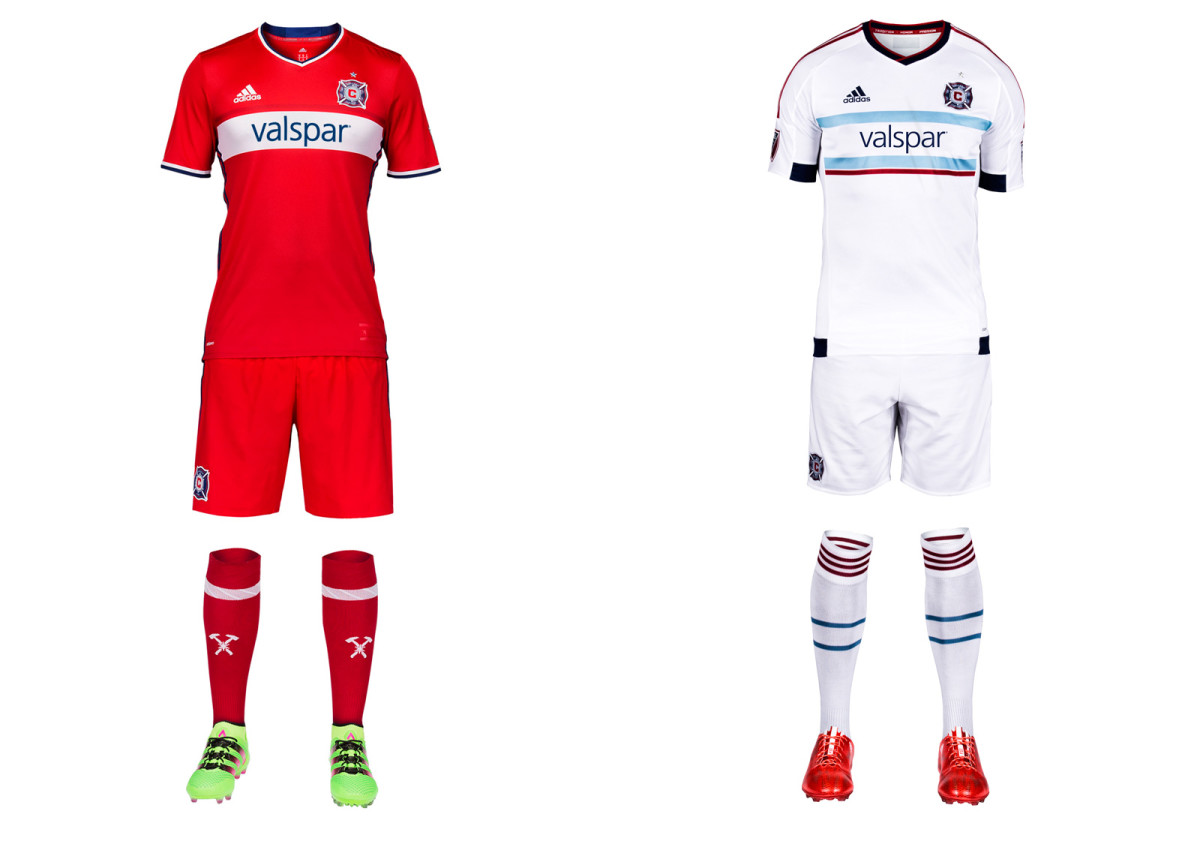
The optimism surrounding a new GM and head coach is accompanied by a welcome return to the red kit and single white hoop the Fire wore when winning trophies. Chicago was the first MLS team in mono-red and has dibs on a look that unfortunately became way too prevalent. The hoop on the new primary uniform is too thin, but otherwise it’s a crisp design that should be well received by fans, some of whom protested the red-and-blue offering worn in 2014-15. The all-white away kit featuring hints of the city flag carries over from last year.
Colorado Rapids
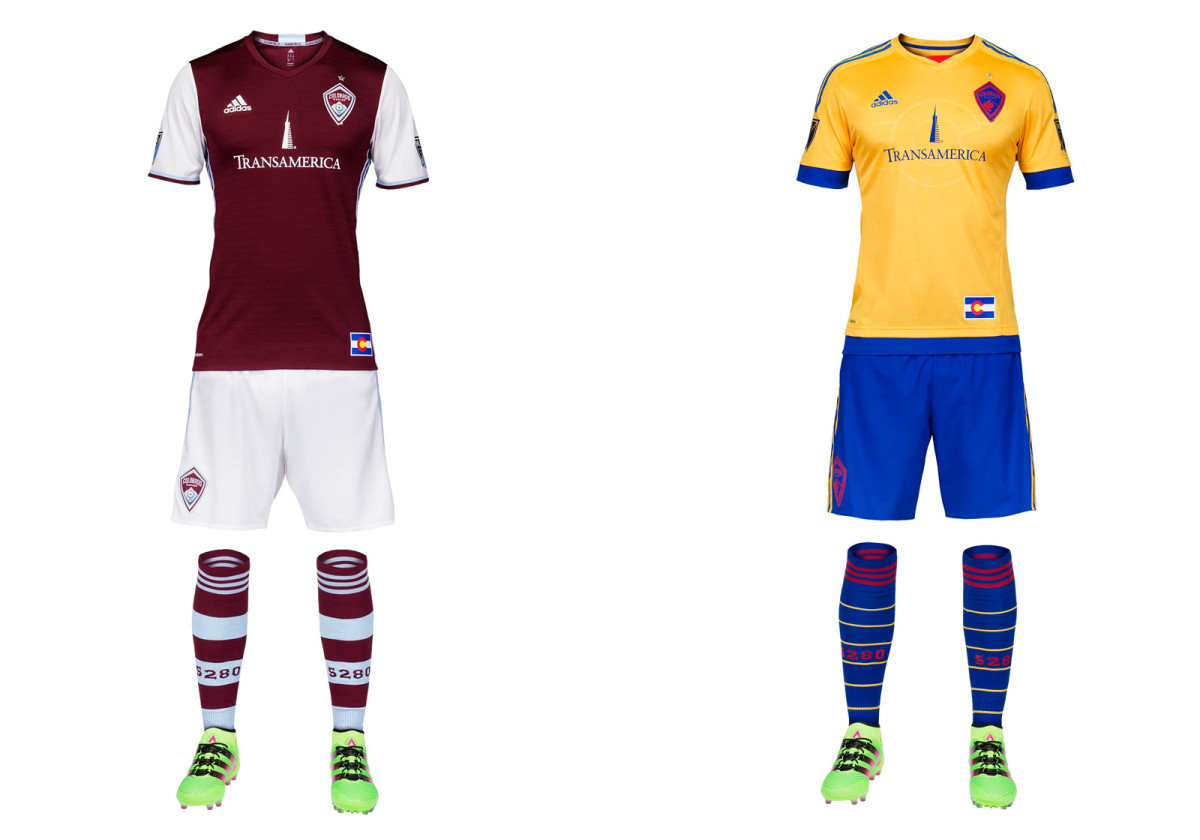
Colorado made just a few very subtle changes to its home uniform this year, and that’s fine. The three stripes moved from the shoulder to the side, there’s a bit of color on the cuffs and the hoops on the sock widened, which is awesome. The burgundy and white is elegant and immediately recognizable. The club's problem remains the logo, a skinny shield featuring a mountain (not rapids) similar to its NHL, NBA and MLB neighbors. It’s tough to suggest a fourth crest for a team that’s had trouble establishing an identity, but it might help. This one leaves no impact. Colorado’s sharp state flag-inspired away set carries over from 2015.
Columbus Crew SC
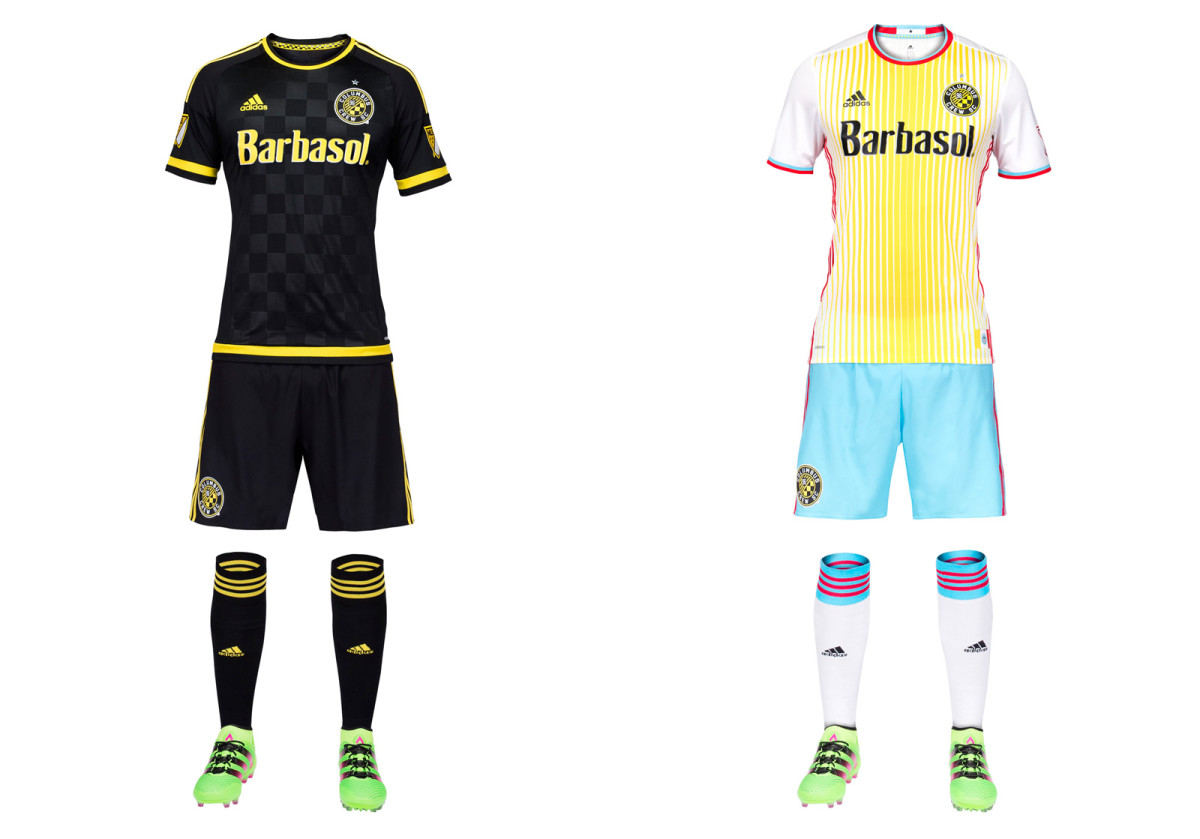
Once known as "America’s Hardest Working Team," Crew SC is trying too hard. For 17 years, Columbus was the only club in MLS, and one of the few in the world, to wear all-yellow. It was immediately recognizable, looked great on the field and was a genuine brand. Now it’s gone, replaced as the primary by last year’s away set. Mono-black is more closely associated with D.C. United. The new secondary is a shock to the system. Designed to reflect the yellow, white and red city flag, it’s certainly distinctive. Clubs are welcome to take chances with their away kits, but only if the overall brand holds steady.
D.C. United
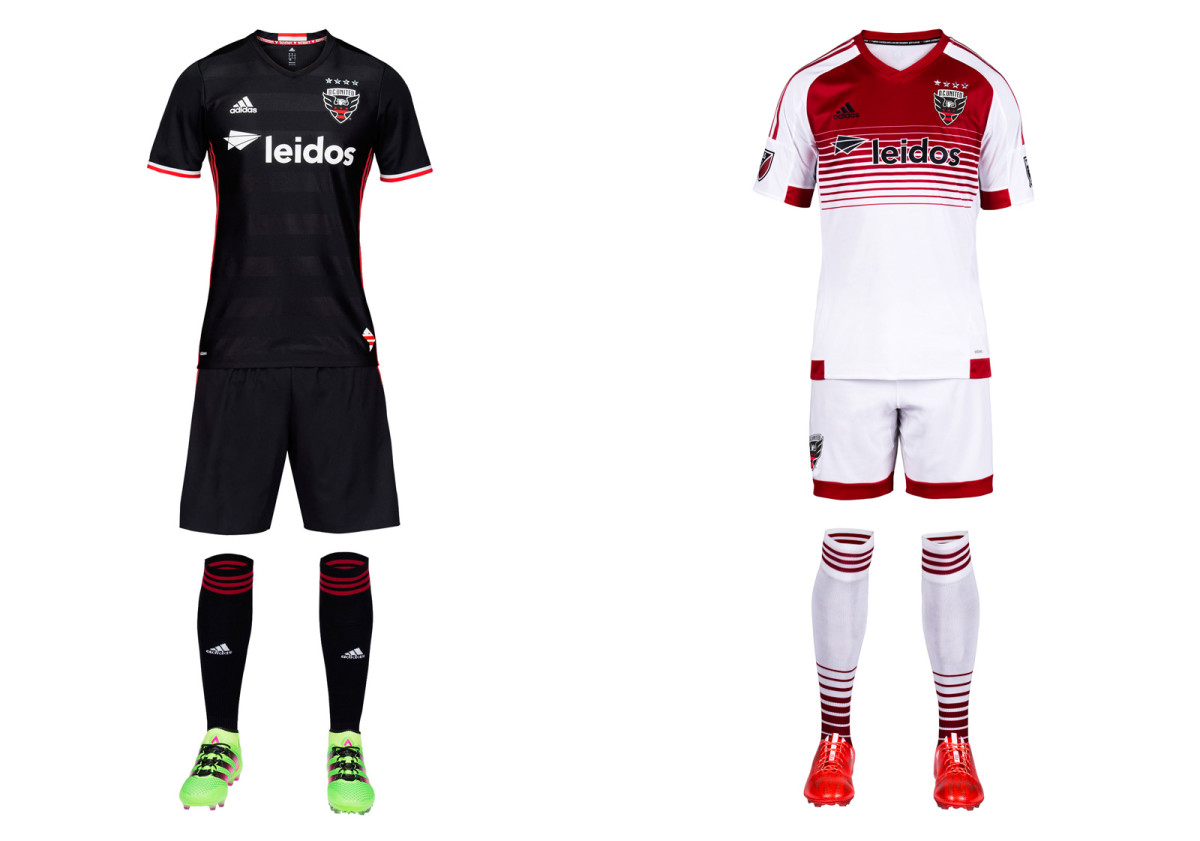
A new stadium in the nation’s capital (scheduled to open in 2018) is preceded by a new club logo, United’s first since 1998. We love the wings breaking through the shield and the redesigned font, but wish the stars on the city flag–which replaces the old ball and championship star–were a bit larger. They’re lost on the black background. The new home kit maintains the club’s classic, all-black brand and the sad absence of the white chest stripes that adorned the most iconic uniform in MLS history. There must be a way to bring those back.
FC Dallas
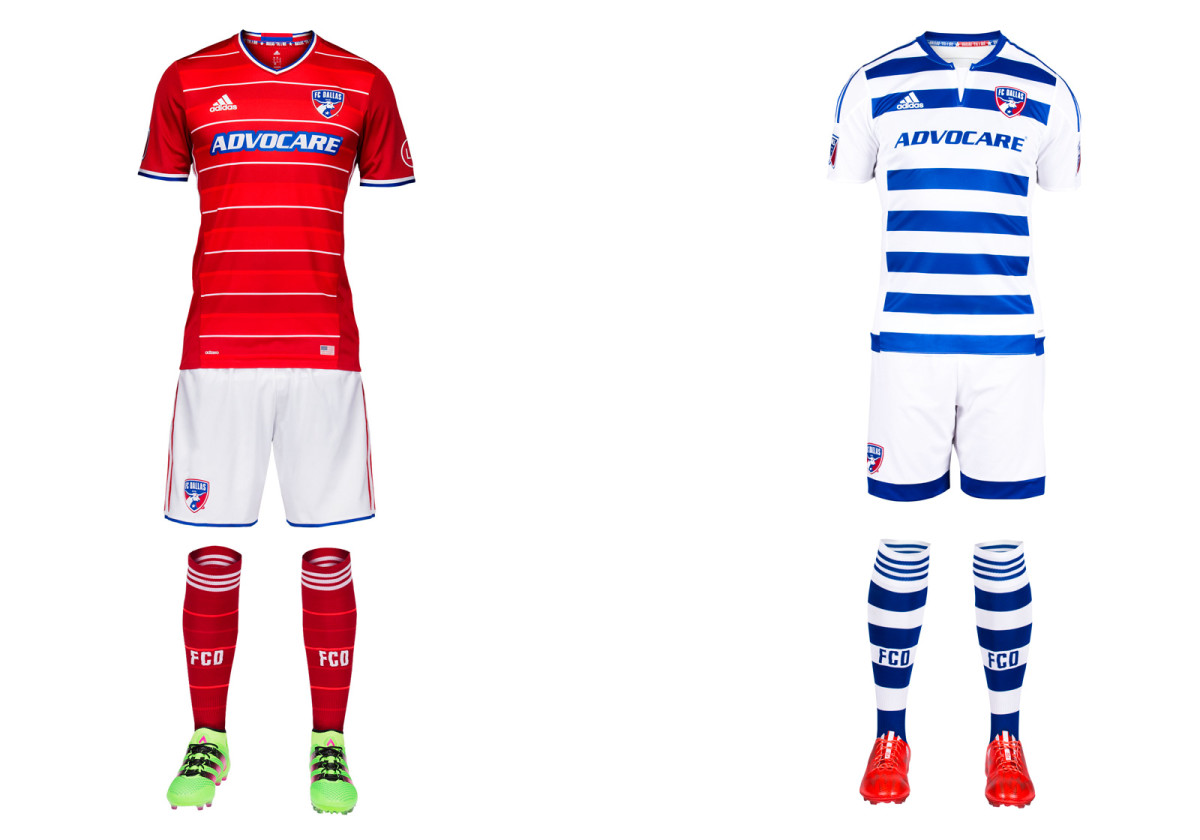
FCD’s new home kit is the nicest in club history. The hoops that accompanied the 2005 rebrand were a good idea but always poorly executed, and Dallas gave up on them two years ago. But the common mono-red look was a failure, leading to this year’s stylish primary. The pinstripe white hoops are sleek and distinctive and aren’t overwhelmed by Adidas’s panels and seams. The uniform pops with the addition of white shorts. Hopefully FCD takes the same approach with the blue-and-white secondary kit next year.
Houston Dynamo
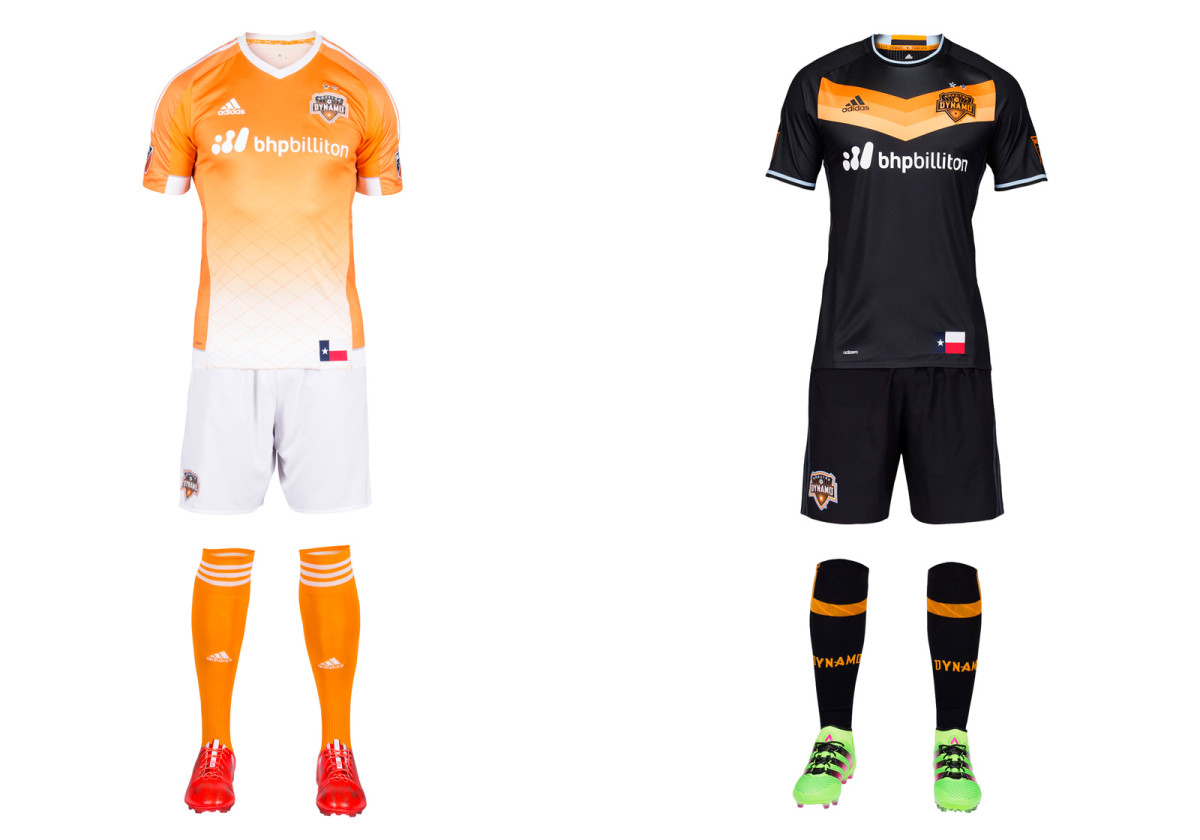
Houston’s new away uniform is a stunning departure from the traditional white. Black has been part of the club’s palette (check the logo). It now dominates the secondary kit save for a bright orange chevron on the chest reminiscent of the Astros’ famous “Tequila Sunrise” jerseys and the shirts Germany wore when winning the 2014 World Cup. We may not see the black too often at home (it’s hot and humid in Houston), but it should sell well. The orange fade on the primary set carries over from 2015. The Dynamo occasionally wear mono-orange, which is a mistake. The white shorts remain the way to go.
LA Galaxy
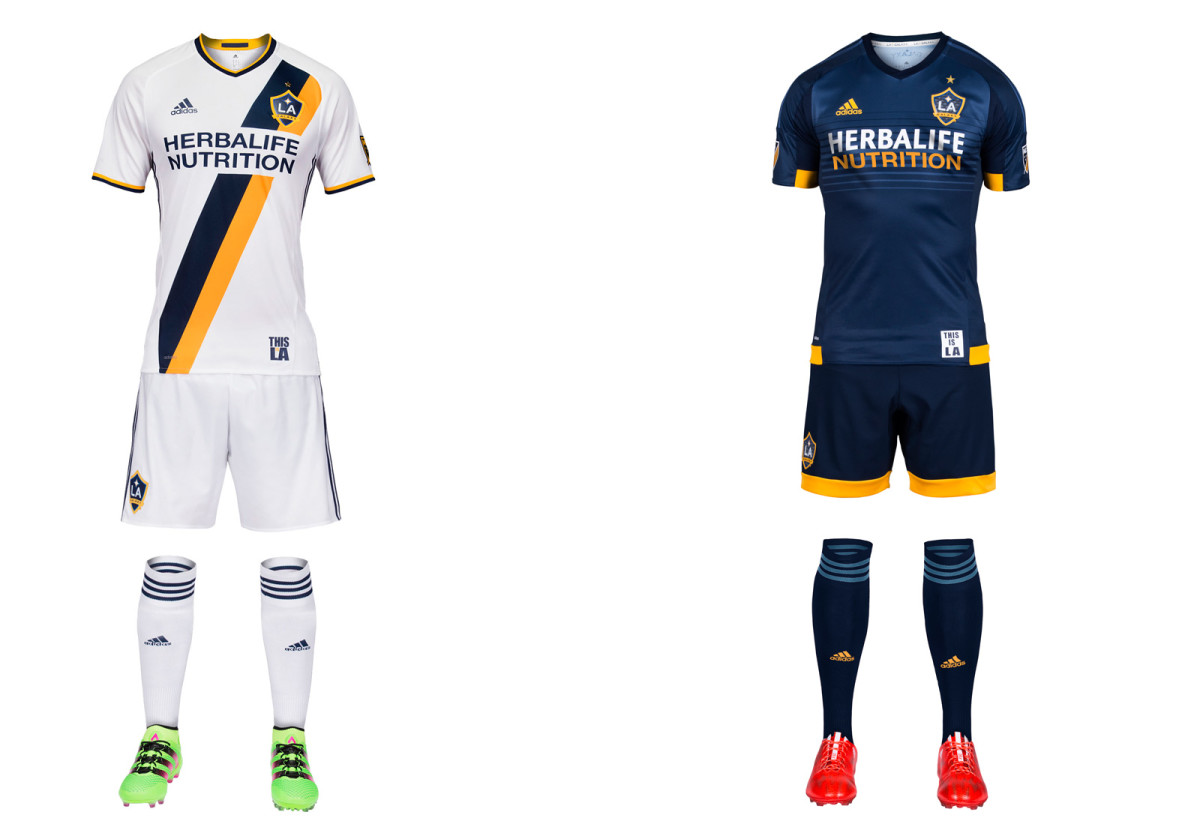
Credit to LA for sticking with the sash introduced in 2012. A club that started black-and-teal and progressed to yellow-and-green finally has an established look to call its own, and it’s a nice one. The new home uniform splits the sash into the modern team colors of blue and yellow, with corresponding flashes on the cuff and collar. It would be perfect save for the enlarged sponsor logo, which cuts too much from the middle of the shirt. The Galaxy carry over their classy blue away kit and thanks to the league's complex new championship star system they'll now wear one gold star above the crest, symbolizing five MLS titles.
Montreal Impact
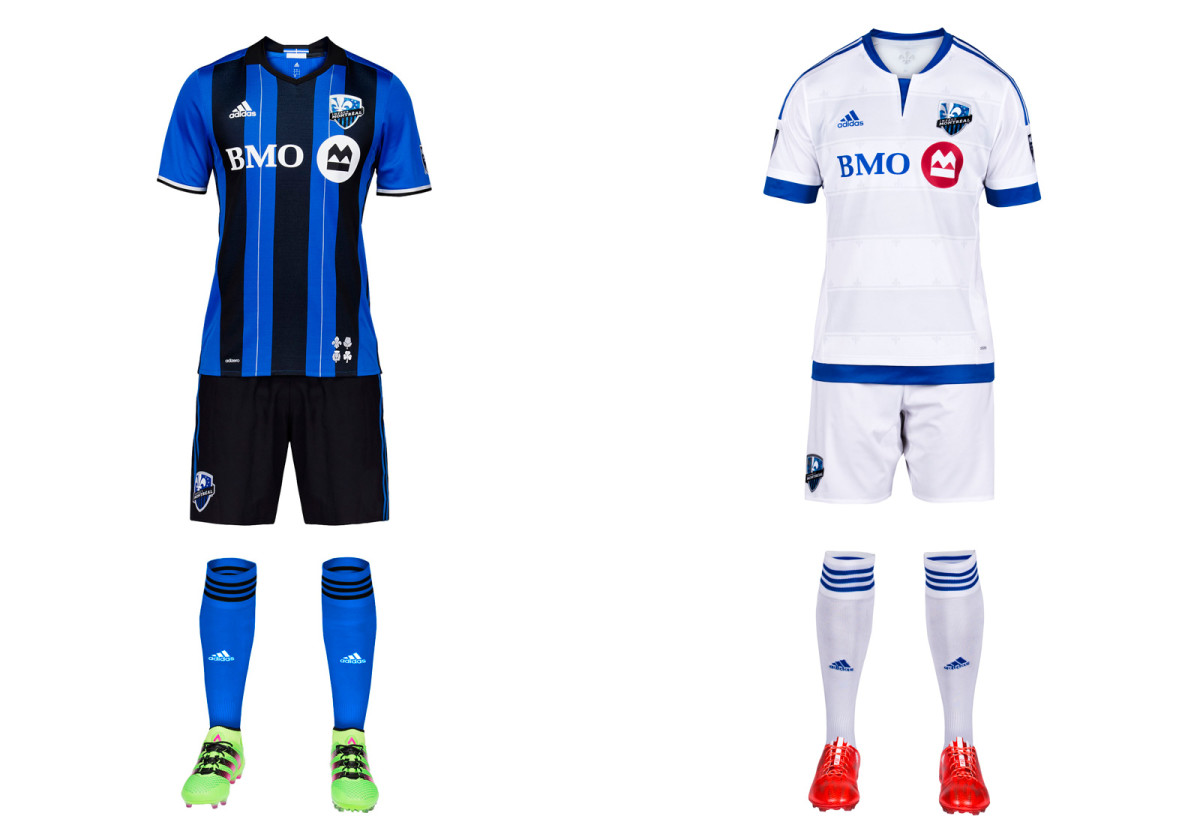
Finally! We never could understand why the Impact (launched in 1993) didn’t opt for their old school blue and black stripes when moving to MLS in 2012. There was history with the plain blue primary as well, but in the end it was just another anonymous monochromatic uniform in a league full of them. The stripes returned as a popular third option in 2013 and now have been elevated to their proper place as Montreal’s home kit. Black shorts, blue socks and silver highlights round out one of MLS’s most distinctive looks. Maybe the Impact can wear those shorts and socks on the road as well.
New England Revolution
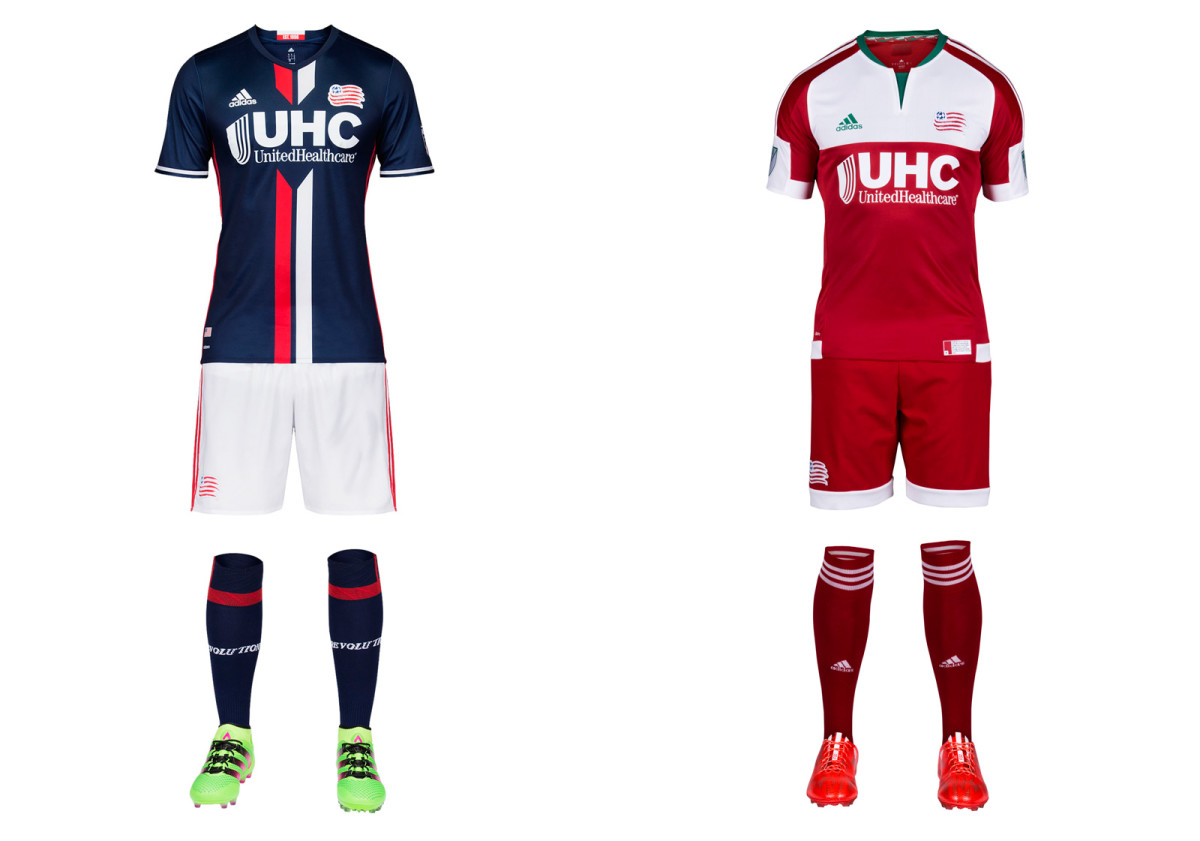
No team embraced the post-1996 regression to the bland like the Revs, who wore the most nondescript uniforms in MLS for years. That changed in 2014 with the addition of white shorts to the navy blue home kit. A total departure from the old all-white aways—a red homage to the old regional flag—followed last year. This season’s primary represents another step forward. The white shorts remain, thankfully, while a beautiful new jersey features red and white stripes down the center. The club said the look is inspired by American Revolution-era jackets. The secondary kit carries over. The inspiration there is commendable but the boxy execution is lacking.
New York City FC
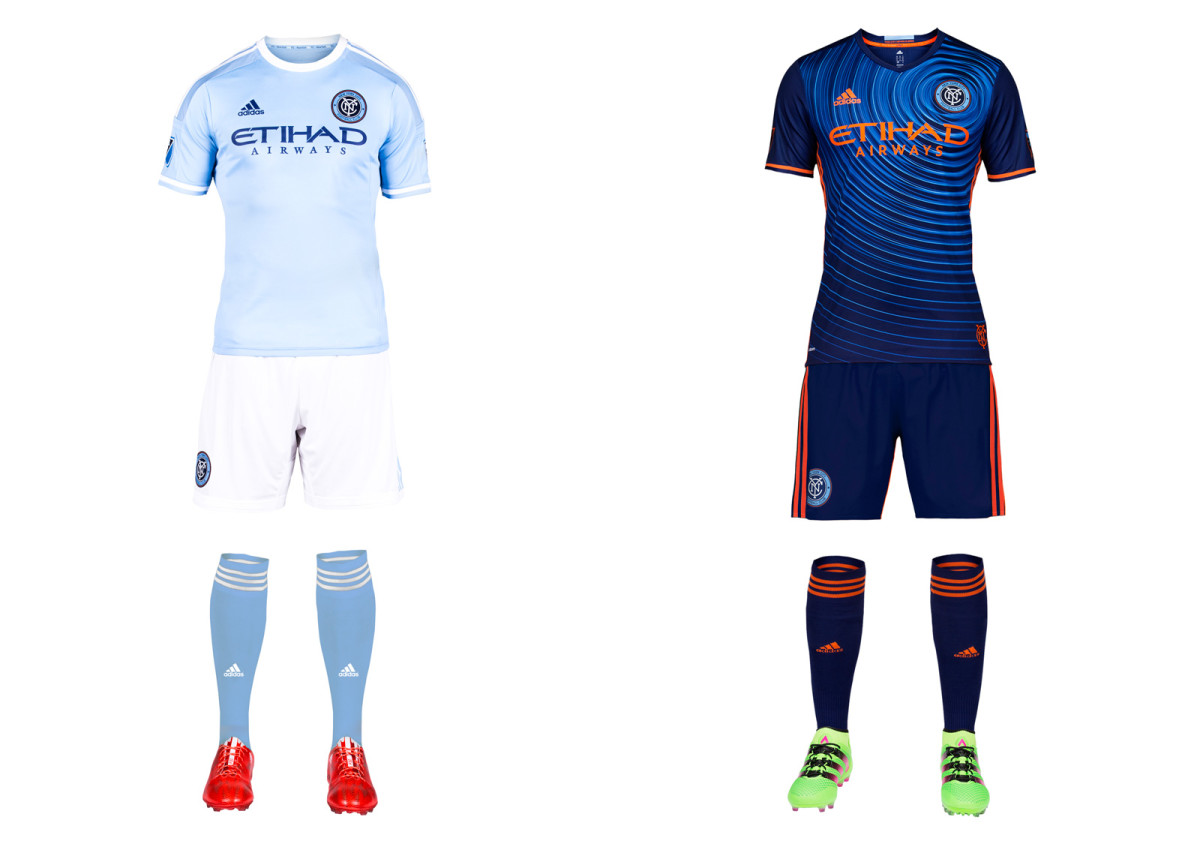
MLS didn’t need another all-black uniform, and NYCFC did the right thing by ditching last year’s away set in favor of something more aligned with the club’s colors and branding. What they came up with, however, will take some getting used to. The dizzying new secondary kit is anchored by a blue jersey with a “ripple pattern inspired by the energy of the five boroughs.” It’s unique, for sure, and while some won’t like it, secondaries don’t necessarily need to be timeless. Adidas also supplied orange shorts as an option, in case the mono-blue isn’t loud enough. NYCFC’s classy home uniform, which looks good even though Manchester City wore it first, carries over from its inaugural season.
New York Red Bulls
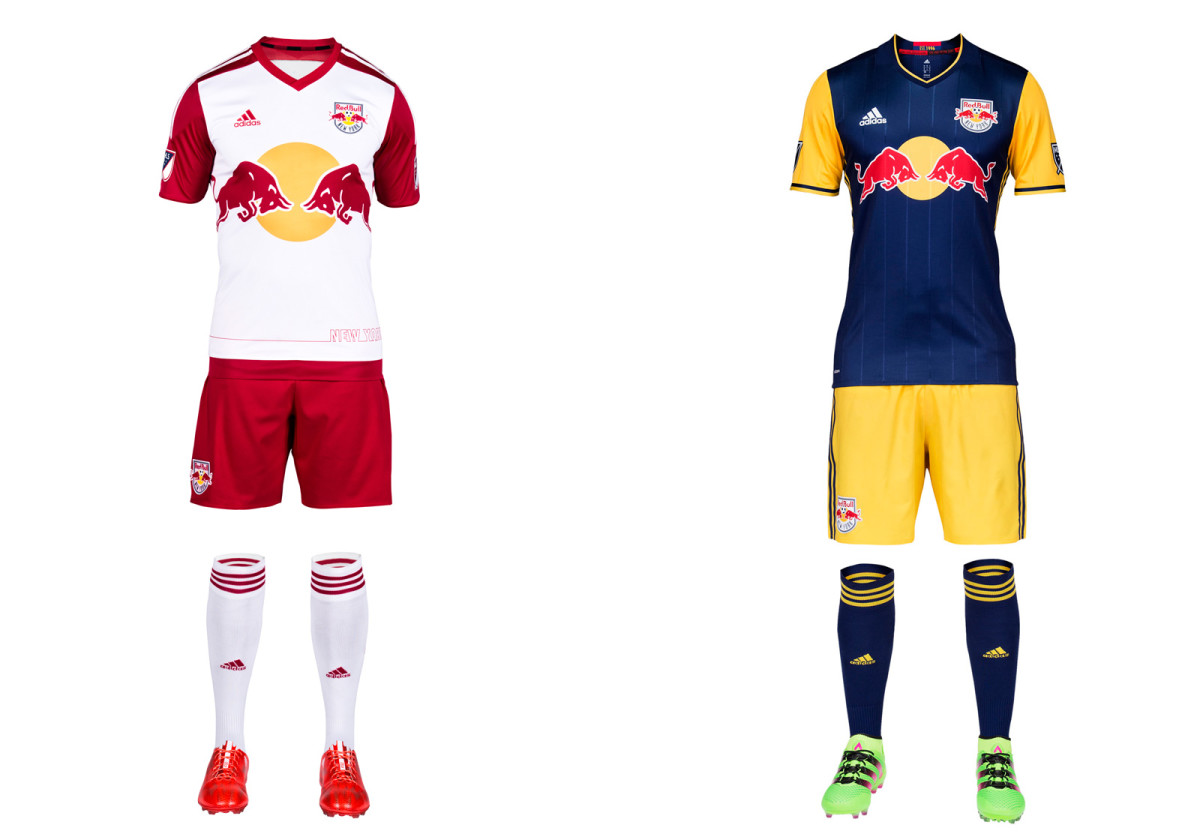
New York is red, except when it’s navy blue and yellow. Despite some supporters’ preference for a red away uniform, the Red Bulls are sticking with the colors they share with the parent company’s teams in Leipzig and Salzburg. The new secondary, which now features yellow sleeves, certainly is eye-catching even if it doesn’t stir fans’ souls. NYRB’s brand transcends the crest and kit, anyway. The stadium, history and the personalities who’ve donned MetroStar red-and-black and Red Bull red-and-white are what give this club its identity. NYRB sort of acknowledges that with the red-and-black necktape and MetroStars shield inside the new away jersey. The red-sleeved home kit is identical to last year’s.
Orlando City SC
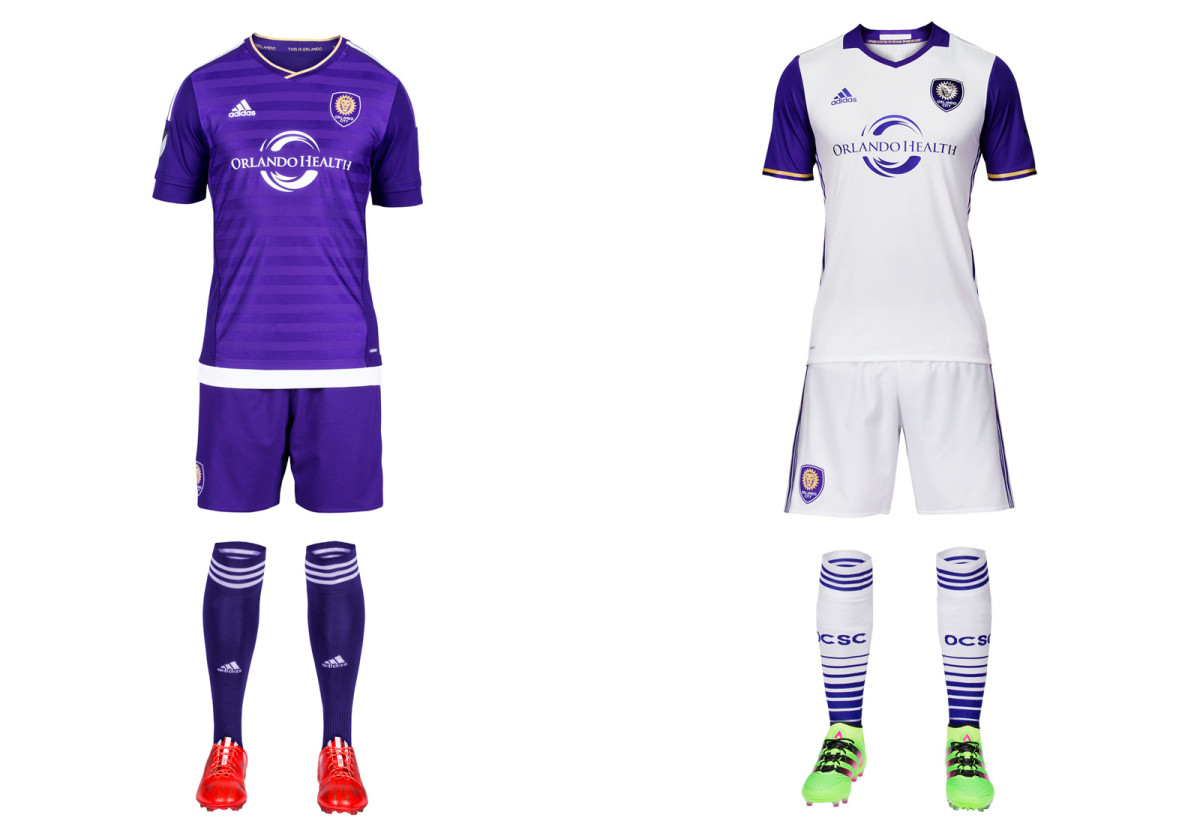
Purple is the defining feature of Orlando City’s brand, but the club blew it during its expansion season by rolling out a plain white away kit that looked too much like all the others. Now there’s progress in the form of purple sleeves, which add a welcome bit of color and make the new secondary uniform one that only Orlando could wear. The crest features a "3D" lion. The monochromatic home set stays the same. Swap the socks–white at home and purple on the road–and City would be close to perfect.
Philadelphia Union
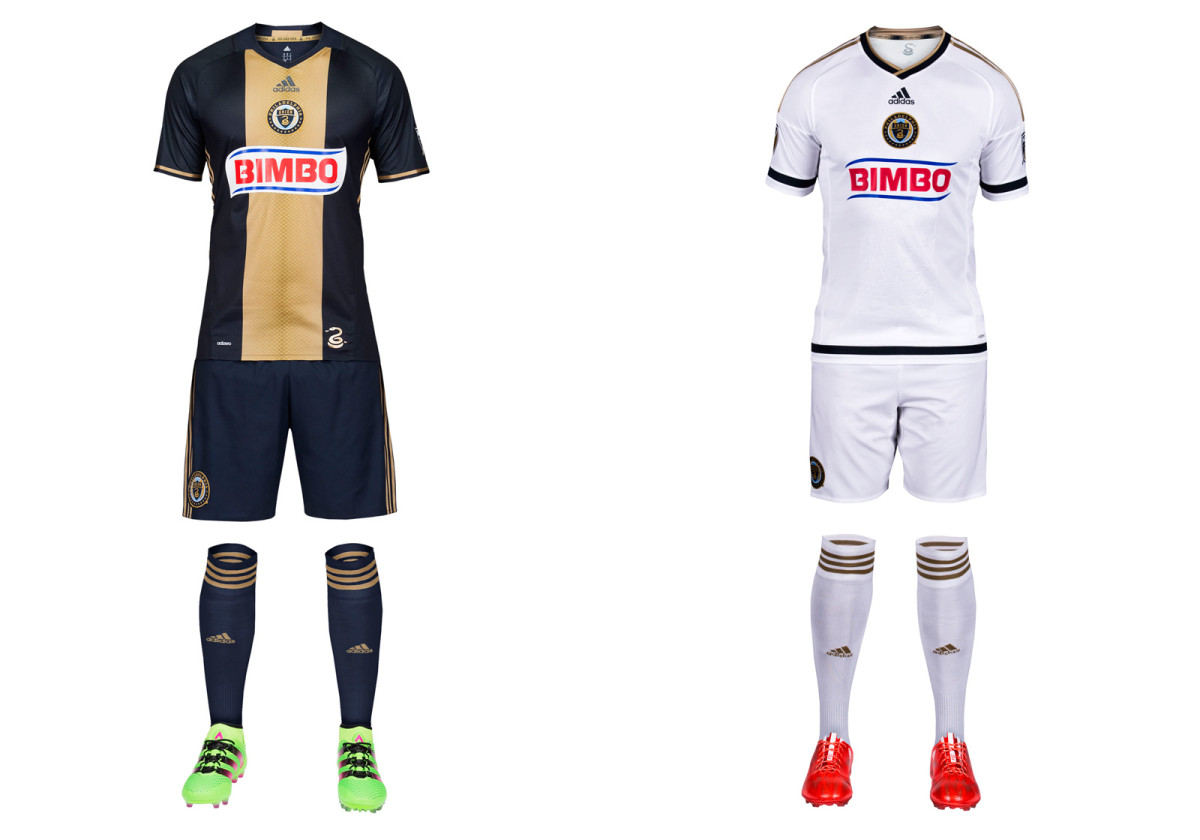
The Union’s home uniform is a modern classic, apart from a garish sponsor logo that looks pasted on instead of integrated with the rest of the jersey. This year’s new primary kit features a lighter gold down the middle, an understated snakeskin pattern (taken from the serpent in the club logo) and the departure of the pinstripes used in 2014-15. It’s as classy and distinctive a set as you’ll find. If only Bimbo could cooperate. Meanwhile, we’re stuck with the regrettable, lazy away kit for one more season.
Portland Timbers
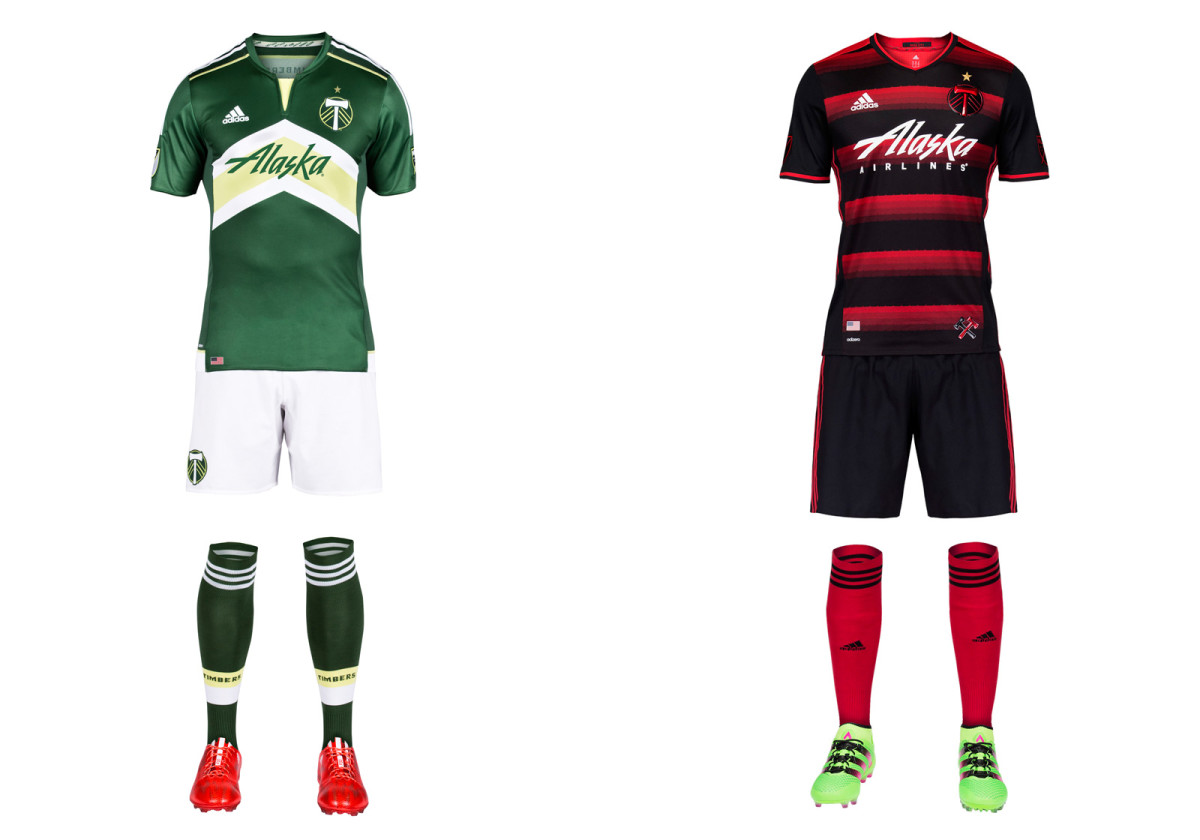
Portland’s "Rose City Red" away uniforms continue to darken, but the overall theme is maintained with the champions’ striking new secondary set. The mostly-black jersey (there's more red on the back) features hoops in shades of red complete with a subtle thorn motif. Red socks add a bit of contrast that would be lost if they were black. The green-and-white home kit is the same as last year’s except for a revised sponsor logo. For Timbers fans, of course, the best part is the new gold star above the crest.
Real Salt Lake
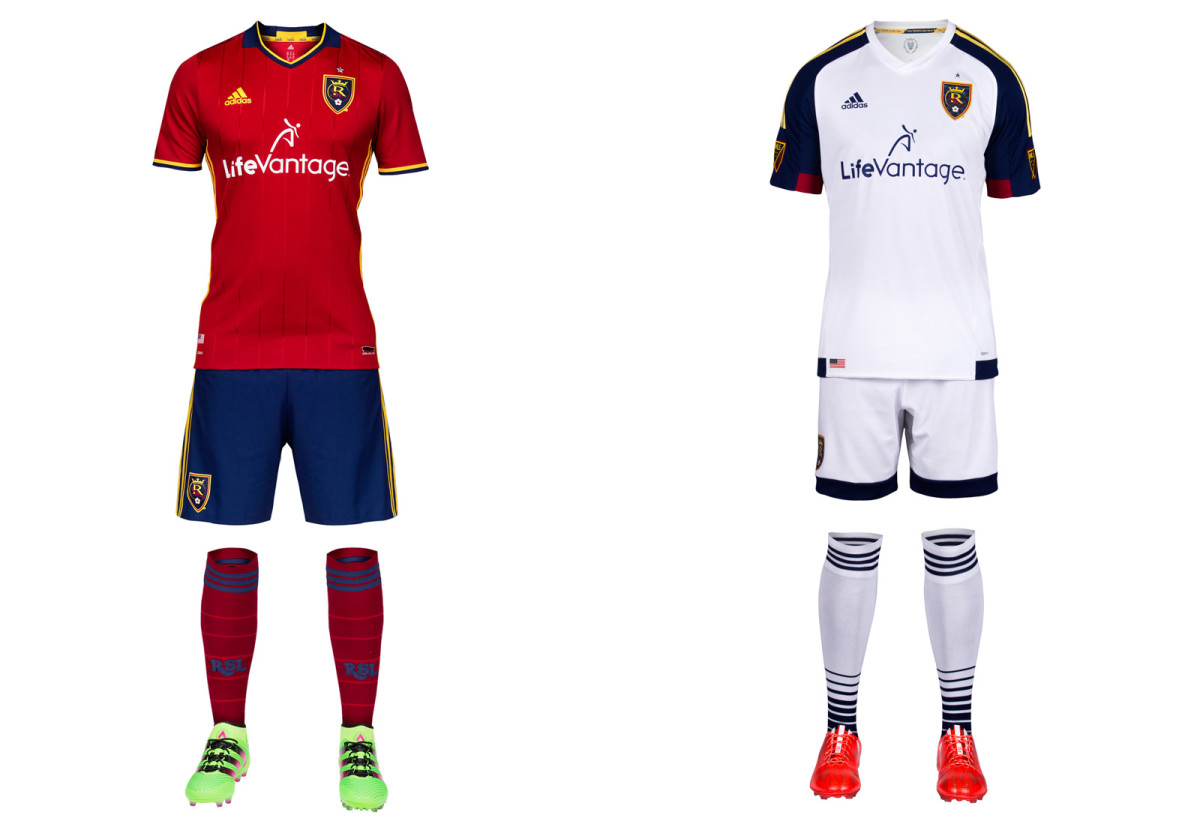
After six years in all-red, RSL at long last is returning to something resembling its unique, championship-winning look. After claiming the 2009 MLS title in red/claret jerseys (with blue/cobalt sleeves), blue shorts and blue socks, RSL inexplicably opted to become one of several mono-red teams. Bad uniforms and a trio of lost finals followed. If there was a kit curse, consider it reversed with the new home set, which features sublimated pinstripes on a sharp red jersey and a return to the cobalt shorts. RSL is RSL again. Let’s hope some variation of “victory gold” replaces the all-white secondary kit in 2017.
San Jose Earthquakes
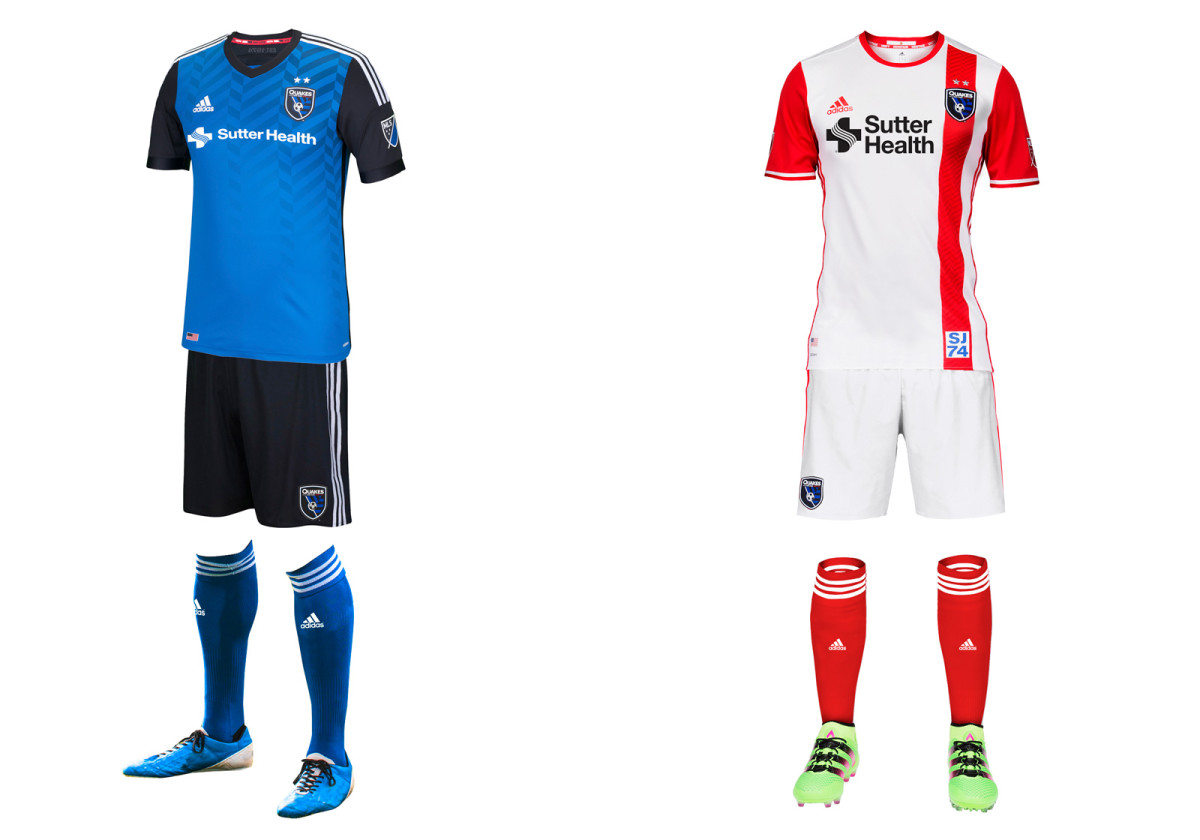
San Jose’s 2014 brand refresh now feels finished with the introduction of a much-improved away set that actually features some red, which connects the modern-day Quakes to their 1970s and ‘80s predecessors. The red stripe, sleeves and socks create a unique, balanced look that ties the club’s crest, primary and secondary kits together. There's also a tiny scorpion inside the neck paying tribute to the branding fiasco that was the San Jose Clash. The sharp blue-and-black home uniform carries over from last season with the addition of the Sutter Health logo. The Earthquakes were the last holdout—for the first time, every MLS team has a jersey sponsor.
Seattle Sounders FC
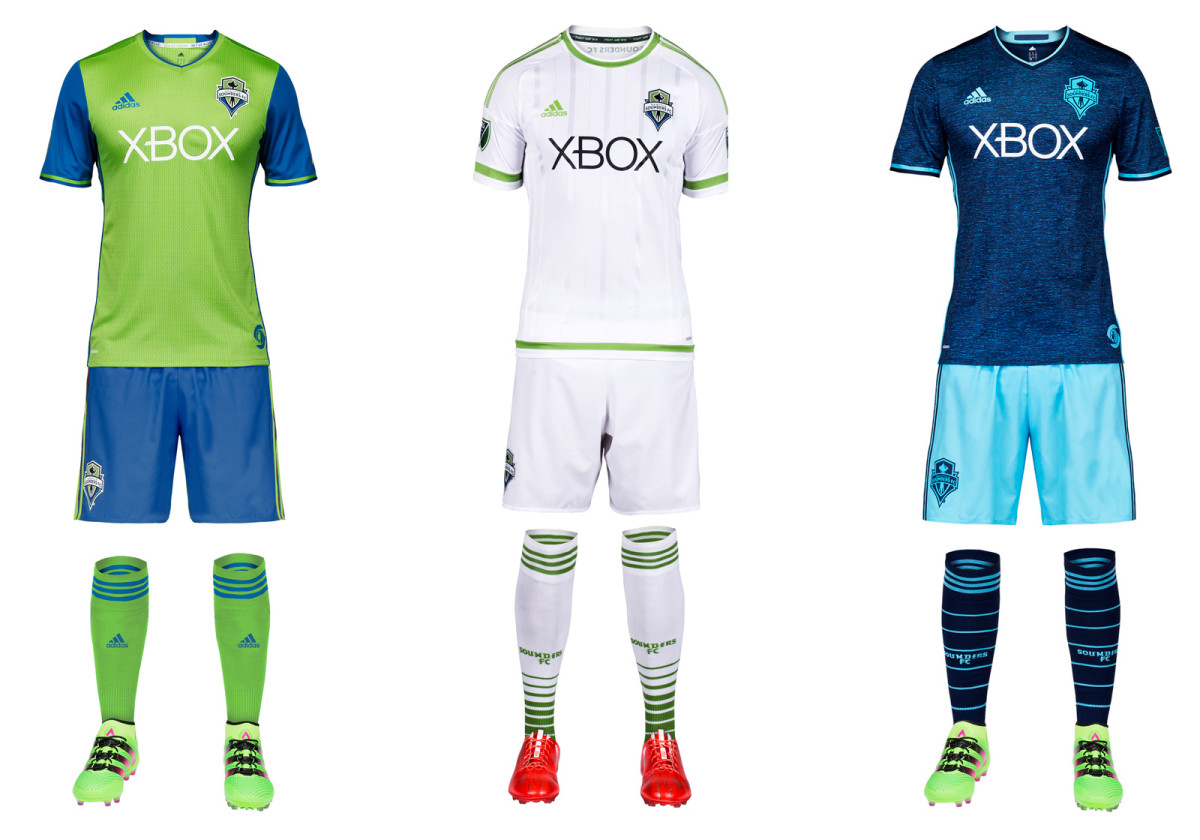
The only club to introduce two uniforms this year, the Sounders will sport a slightly adjusted version of their iconic rave green primary and a new third kit designed to reflect the colors of Puget Sound. The home set now features blue sleeves and an ’SS’ pattern on the body of the jersey. Seattle may continue the odd tradition of swapping the shorts and socks when wearing the primary on the road. It returns to cyan (and shades of darker blue) on the new third kit, which has a nice Cascadia feel. Hopefully, its arrival means the Sounders will wear the silly all-white secondary as infrequently as possible.
Sporting Kansas City
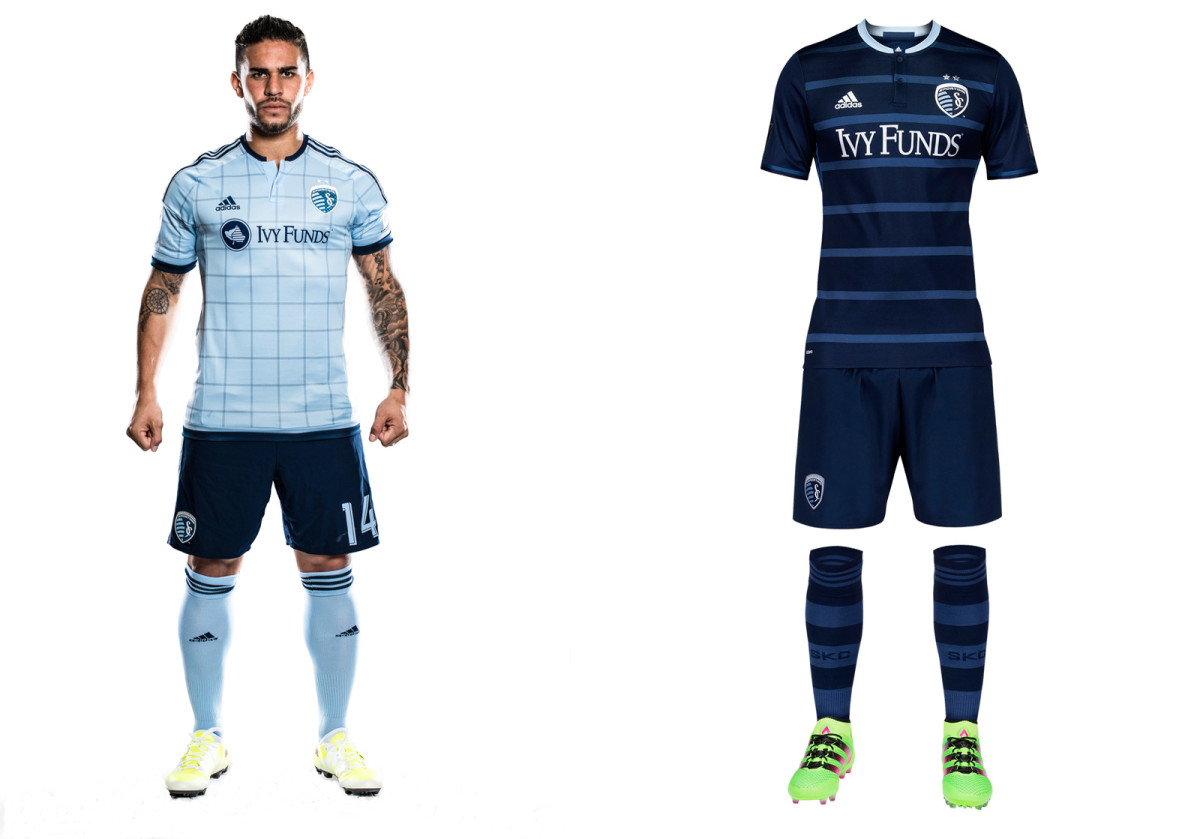
Uniforms typically run on two-year cycles, meaning Sporting had no choice but to move on from its spectacular hooped 2014-15 away set. The replacement is nice enough and the jersey looks good on its own, but the full kit is a bit bland in comparison. The thin hoops are "tonal" rather than "Sporting" blue. The metallic silver numbers and sponsor logo add a bit of glitz. The checkered home uniform debuted last year and still looks good with the dark blue shorts. SKC also will continue wearing its all-white third kit on occasion.
Toronto FC
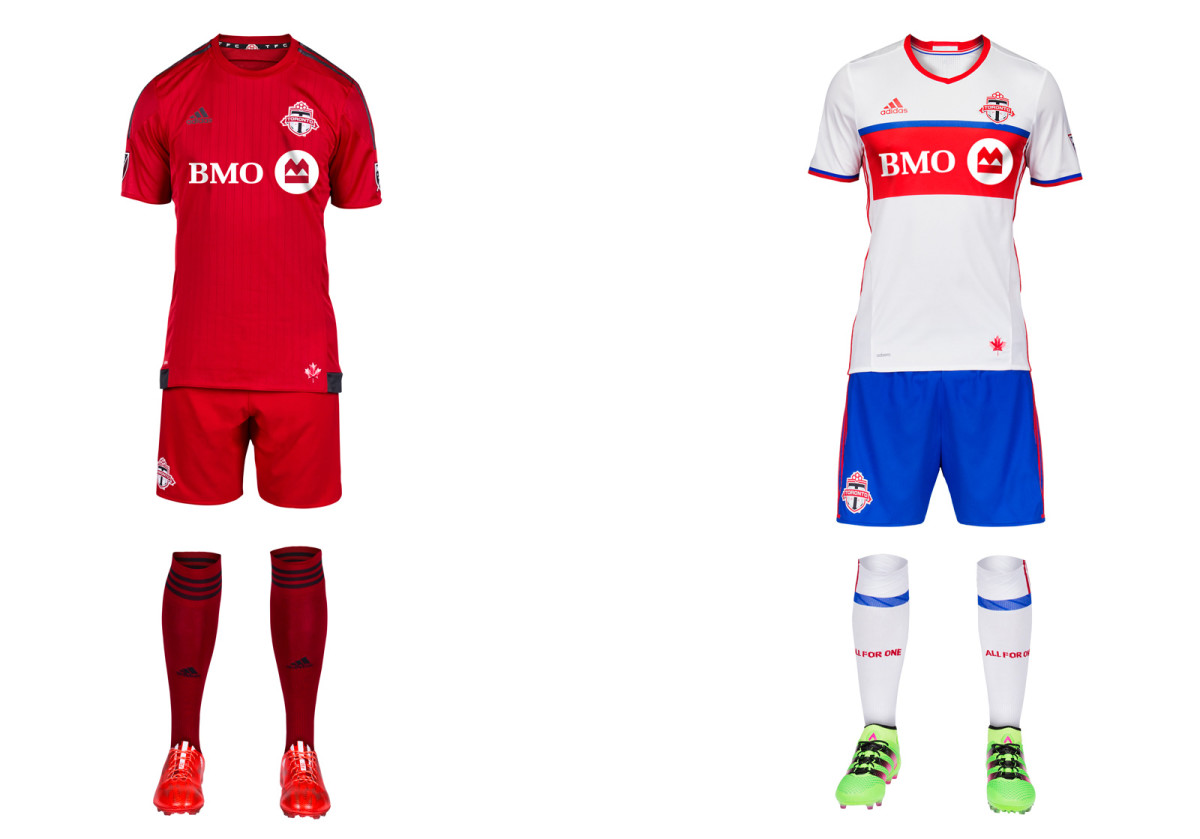
Entering its 10th season, TFC will include blue in its uniform for the first time. The club’s new away uniform is a colorful nod to the city and its soccer past. Toronto’s flag and its NHL, MLB and CFL teams are primarily blue, and the NASL’s Metros-Croatia and Blizzard wore red and blue in the 1970s and ‘80s. The kit stands out without being garish and means something to the club. Well done, TFC. It also can be worn with red shorts. Gone is the classy dark gray, which we wish was more prominent in the all-red primary.
Vancouver Whitecaps
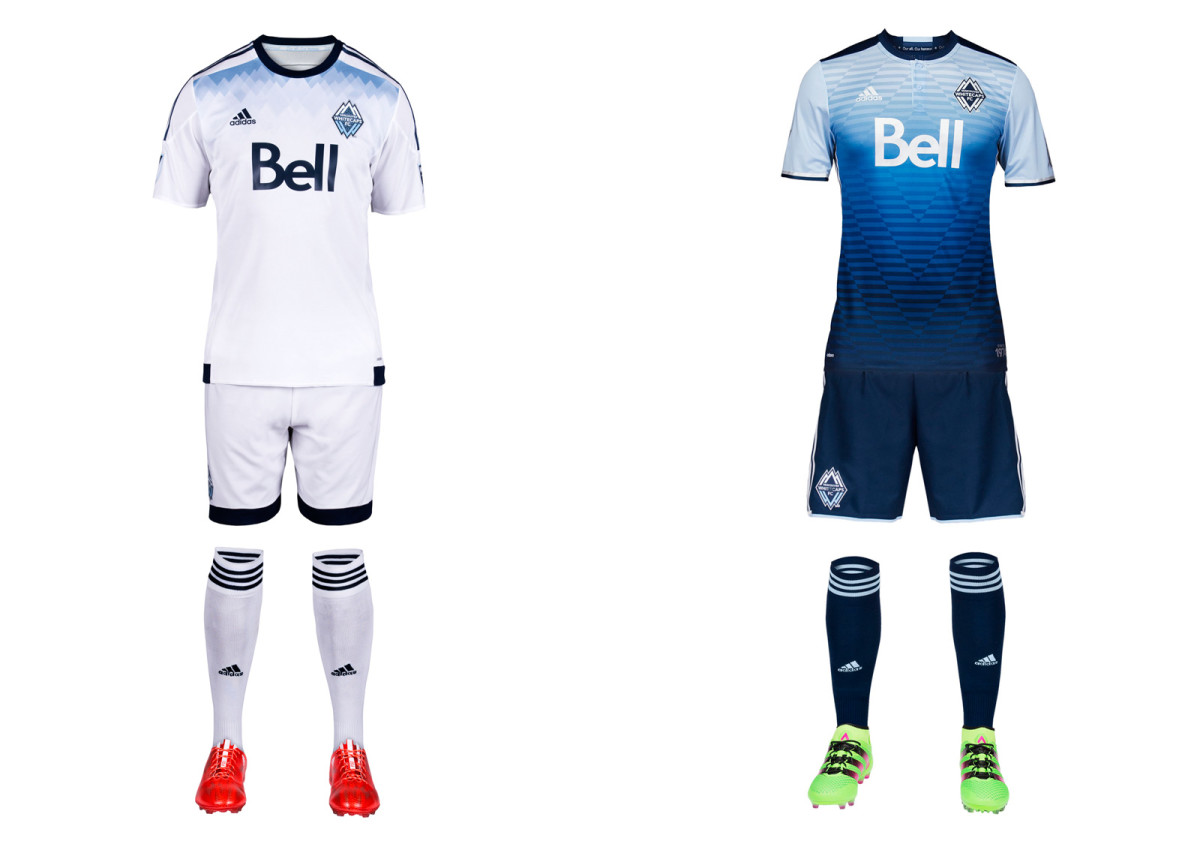
Vancouver’s new away uniform is its most daring design to date, barring the brown third kit introduced in 2012. But where that one was forgettable, the team’s “Sea to Sky” jersey leaves an impression. The blue gradient evokes the horizon, the North Shore Mountains reflecting on the surface of the water and the club’s initials. It’s gorgeous. The all-white primary carries over from 2015. It includes a bit of subtle blue shading at the shoulders but is otherwise pretty anonymous. The Whitecaps just proved they can do better.
The goalkeepers in general had a lot to do with the Week 1-quality defenses in front of them, and Bush and Blake certainly had plenty of opportunities to shine. They both ended up with eight saves in their respective games.
The variety of Bush’s interventions helped his cause, as he stopped a 1-on-1 early, made a diving reaction save late on to keep the lead and stopped plenty of shots in between. He couldn’t do much about two point-blank chances on set pieces, but he could hardly be faulted, either.
David Bingham also held together the Earthquakes’ victory with several stops, but he looked a little less clean technically than Bush. Bingham can take some solace from the fact that he did keep the shutout, continuing a positive 2016 so far in which he also made his debut for the U.S. men's national team.
Further honorable mentions go to FC Dallas center back Walker Zimmerman and Earthquakes defender Víctor Bernárdez for their roles in their teams’ shutouts. Goal-scoring defenders Kendall Waston and Nuno Coelho impressed on the other end of the field.

1. FC Dallas
PREVIOUS: 3
RECORD: 1-0-0
Óscar Pareja’s men didn’t struggle much to put away Philadelphia, taking a 2-0 win that could have been a lot more lopsided if not for some goalkeeping heroics, but losing Fabián Castillo late could be a big blow.

2. Portland Timbers
PREVIOUS: 1
RECORD: 1-0-0
Despite giving up an acrobatic equalizer to Federico Higuain, Portland pulled out a 2-1 victory over Columbus with an unusual deficit of possession at home, showing that winning games doesn’t always mean having more of the ball.

3. Toronto FC
PREVIOUS: 7
RECORD: 1-0-0
Sebastian Giovinco is back, although he and TFC only needed the last 10 minutes to defeat the Red Bulls, 2-0, on opening day behind a penalty and stoppage-time counterattack.

4. LA Galaxy
PREVIOUS: 5
RECORD: 1-0-0
Perhaps the Galaxy’s goalkeeping headaches aren’t over, as Dan Kennedy came out injured a few minutes after giving up a soft goal in a 4-1 win over D.C. in which LA didn’t get going until the second half.

5. Montreal Impact
PREVIOUS: 8
RECORD: 1-0-0
Ignacio Piatti stepped up in a big way in Didier Drogba’s absence, having a hand in every goal the Impact scored in a 3-2 win in Vancouver and showing that this might not be just a one-man attack.

6. New York Red Bulls
PREVIOUS: 4
RECORD: 0-1-0
More than 80 minutes of dominance, to the tune of 63% possession, ultimately meant nothing for the Red Bulls as they lost to two late Toronto goals.

7. Sporting Kansas City
PREVIOUS: 11
RECORD: 1-0-0
Ironically, Coelho didn’t even look like he wanted the ball just moments before his long-range shot squeaked into the net to give Sporting a 1-0 road win in Seattle on opening day.

8. Columbus Crew SC
PREVIOUS: 2
RECORD: 0-1-0
Higuaín’s overhead kick will be up for Goal of the Week, but the Crew will be disappointed it couldn’t do better than a 2-1 loss at Providence Park despite having more than 60% possession.

9. New York City FC
PREVIOUS: 14
RECORD: 1-0-0
It was pretty sloppy, and you’d expect a team coached by Patrick Vieira to defend better than it did in Chicago, but a 4-3 win in the Frenchman’s first match in charge is all that mattered.

10. San Jose Earthquakes
PREVIOUS: 17
RECORD: 1-0-0
In a game featuring the Earthquakes’ trademark direct play, Chris Wondolowski scored just moments into the second half to lift San Jose over Colorado by a solitary goal.

11. Vancouver Whitecaps
PREVIOUS: 6
RECORD: 0-1-0
In a 3-2 loss to Montréal, familiar issues resurfaced for the Whitecaps, who dropped 22 points at home in 2015, as Carl Robinson’s team continues to look more comfortable playing on the counterattack than controlling play.

12. Seattle Sounders
PREVIOUS: 9
RECORD: 0-1-0
Oniel Fisher’s straight red card just before halftime killed the Sounders’ chances in a 1-0 loss to Sporting Kansas City, as Seattle conceded much of the control it had on the game with its full complement on the field.

13. New England Revolution
PREVIOUS: 13
RECORD: 0-0-1
It’s been a couple years since Diego Fagúndez’s 13-goal 2013 season marked him as a player to watch, but the Uruguayan showed that he’s still more than capable, scoring once and assisting twice in a comeback draw in Houston.

14. Houston Dynamo
PREVIOUS: 18
RECORD: 0-0-1
Even without Cubo Torres, Houston looked more exciting in attack than it did in 2015, playing to a six-goal draw against New England; now, the focus has to be shoring up the back line.

15. Real Salt Lake
PREVIOUS: 15
RECORD: 0-0-1
Not injured from the start of the season this time, Plata made good on his clean health with a goal on either side of halftime, but RSL collapsed late to lose two points on the road to Orlando.

16. Orlando City SC
PREVIOUS: 12
RECORD: 0-0-1
The Lions put together a wicked comeback in front of over 60,000 at the Citrus Bowl, scoring twice in stoppage time to tie RSL, in a reversal of late-game fortune from 2015, when Orlando came out on the wrong end of a series of late-game decisions.

17. Chicago Fire
PREVIOUS: 16
RECORD: 0-1-0
After an undefeated preseason, Chicago got nothing out of its first regular-season game, a 4-3 loss to NYCFC that marked the first time the Fire didn’t have complete control under Veljko Paunović.

18. D.C. United
PREVIOUS: 10
RECORD: 0-1-0
After going up 1-0 early in LA, it was a classic defensive D.C. performance, falling back in the face of the Galaxy’s advantage in possession and shots before eventually seeing its advantage turned into a 4-1 loss.

19. Colorado Rapids
PREVIOUS: 20
RECORD: 0-1-0
Colorado got off 18 shots and kept nearly 60% possession against San Jose but, mirroring a 2015 in which the Rapids were MLS’s lowest-scoring team, couldn’t put any in the back of the net in a 1-0 loss.

20. Philadelphia Union
PREVIOUS: 19
RECORD: 0-1-0
Without Maurice Edu and Tranquillo Barnetta in the lineup due to their respective injuries, the Union didn’t make many strides forward from the way it finished last season in a 2-0 loss to Dallas.
